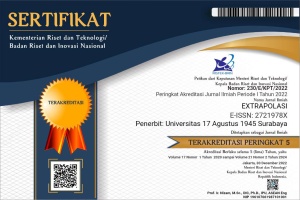Penerapan Pengendalian Kualitas menggunakan Statistical Process Control (SPC) dalam Upaya Meningkatkan Manajemen Mutu
Abstract
In the construction of buildings, where the volume of concrete used is substantial,
conducting casting only once is not feasible. Therefore, the repetitive casting process
necessitates strict supervision and control to ensure its quality. Deviations in the quality
of concrete in a construction project can significantly impact non-performance costs and
the project's implementation timeline. This research aims to analyze the variability and
trends in concrete quality during the construction of the project. The method employed in
this study is the Statistical Process Control (SPC) method to control the quality of
concrete production. This research is of a qualitative descriptive nature, where data is
extracted from production process inspection documents owned by the technical and
quality departments of the contractor. The analysis results indicate that the variability in
compressive strength can be considered good, as it yields relatively uniform concrete
strength. The evaluation of concrete quality, in accordance with the SNI 03-2847-2019
standard on the Procedure for Calculating Concrete Structures for Buildings, shows that
the quality of concrete in the construction project of Apartment X in Surabaya can be
categorized as meeting the requirements for concrete with a strength of fc 24.06 MPa or
equivalent to Grade K 300. Through the implementation of the SPC method, the quality control of concrete production can be better assured, allowing the construction project
to proceed efficiently and in accordance with the established quality standards.
Downloads
Authors who publish with Extrapolasi agree to the following terms:
- Authors transfer the copyright and grant the journal right of first publication with the work simultaneously licensed under a Creative Commons Attribution-ShareAlike 4.0 International License.. that allows others to share the work with an acknowledgement of the work's authorship and initial publication in this journal.
- Authors are able to enter into separate, additional contractual arrangements for the non-exclusive distribution of the journal's published version of the work (e.g., post it to an institutional repository or publish it in a book), with an acknowledgement of its initial publication in this journal.
- Authors are permitted and encouraged to post their work online (e.g., in institutional repositories or on their website) prior to and during the submission process, as it can lead to productive exchanges, as well as earlier and greater citation of published work (See The Effect of Open Access)









